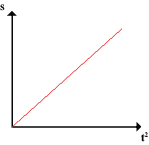
Which of the following motion can be represented by this graph?
A. A ball that is travelling at terminal velocity.
B. A ball that is falling freely from a stationary position.
C. A ball that bounces back from the floor.
D. A ball that is travelling on a rough surface.
Solution
Show solution >>
The answer is C.
The graph shows that s is directly proportional to t2 or
s ∝ t2
∴ s = kt2
Without modifying the points on the graph, we can manipulate this relationship by dividing both sides by t to become:

But, s/t is the velocity of the object. So,
v = kt
Using the relationship between v and t, a graph can be drawn with similarities with the above graph because the gradient, k remains the same and it too will pass through the origin.
From here, we know that the velocity of the object increases uniformly from zero (acceleration is constant). An object free-falling from a stationary position will experience this kind of motion.
Hide solution <<
The graph shows that s is directly proportional to t2 or
s ∝ t2
∴ s = kt2
Without modifying the points on the graph, we can manipulate this relationship by dividing both sides by t to become:
But, s/t is the velocity of the object. So,
v = kt
Using the relationship between v and t, a graph can be drawn with similarities with the above graph because the gradient, k remains the same and it too will pass through the origin.
From here, we know that the velocity of the object increases uniformly from zero (acceleration is constant). An object free-falling from a stationary position will experience this kind of motion.
Hide solution <<
Question source: Malaysia National Physics Competition Panel


No comments:
Post a Comment